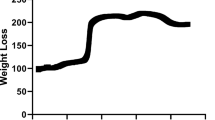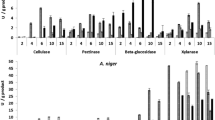Abstract
Mango processing generates significant amounts of residues (35–65%) that may represent environmental problems owed to improper disposal. The use of mango byproducts as substrates to produce hyaluronic acid (HA) is an attractive alternative to reduce the cost of substrate. In this study, we evaluated the potential of hydrolyzates from mango peels and seeds to produce HA by Streptococcus equi. subsp. zooepidemicus. The physicochemical characterization of mango residues showed that the seeds contain a higher amount of holocellulose (cellulose and hemicellulose), which amounts 54.2% (w/w) whereas it only represents 15.5% (w/w) in the peels. Mango peels, however, are composed mainly of hot water-extractives (62% w/w, that include sucrose, fructose, glucose and organic acids). A higher concentration of monosaccharides (39.8 g/L) was obtained from the enzymatic hydrolysis (with Macerex) of peels as compared to seeds (24.8 g/L with Celuzyme). From mango peels, hydrolyzates were obtained 0.6 g/L HA, while 0.9 g/L HA were obtained with hydrolyzates from mango seeds. These results demonstrate that mango byproducts have the potential to be used for production of HA.



Similar content being viewed by others
Availability of data and materials
The datasets generated during and/or analyzed during the current study are not publicly available but are available from the corresponding author upon request.
References
Ammar TY, Pereira TAP, Mistura SLL, Kuhn A, Saggin JI, Lopes Júnior OV (2015) Viscossuplementacão no tratamento da osteoartrose do joelho: uma revisão da literatura (Viscosupplementation in the treatment of knee osteoarthrosis: a review of the literature). Rev Brasil Ortop 50(5):489–494. https://doi.org/10.1016/j.rbo.2014.09.011
Arslan NP, Aydoğan MN (2021) Evaluation of sheep wool protein hydrolysate and molasses as low-cost fermentation substrates for hyaluronic acid production by Streptococcus zooepidemicus ATCC 35246. Waste Biomass Valorization 12:925–935. https://doi.org/10.1007/s12649-020-01062-w
Azaf Ferrari O, Conesa Domínguez C, Seguí Gil L (2016) Pretratamientos para la mejora de la hidrólisis enzimática del residuo de industrialización de la piña para la obtención de bioetanol. Efecto del pretratamiento con microondas en la producción de compuestos fenólicos inhibitorios de la fermentación. Instituto de Ingeniería de Alimentos. (Pretreatments for the improvement of enzymatic hydrolysis of piña industrialization residue for the production of bioethanol. Effect of microwave pretreatment on the production of fermentation-inhibiting phenolic compounds. Institute of Food Engineering). Universidat Politécnica de Valencia. https://riunet.upv.es/handle/10251/71808
Boeriu C, Springer J, Kooy F, Broek L, Eggink G (2013) Production Methods for Hyaluronan. Int J Carbohydr Chemi 14. https://doi.org/10.1155/2013/624967
Chandel AK, Kapoor RK, Singh A, Kuhad RC (2007) Detoxification of sugarcane bagasse hydrolysate improves ethanol production by Candida shehatae NCIM 3501. Bioresour Technol 98(10):1947–1950. https://doi.org/10.1016/j.biortech.2006.07.047
Chen SJ, Chen JL, Huang WC, Chen HL (2009) Fermentation process development for hyaluronic acid production by Streptococcus zooepidemicus ATCC 39920. Korean J Chem Eng 26:428–432
Chong BF, Blank LM, Mclaughlin R, Nielsen LK (2005) Microbial hyaluronic acid production. Appl Microbiol Biotechnol 66(4):341–351. https://doi.org/10.1007/s00253-004-1774-4
Cross C, Bevan E (1907) Researches on Cellulose, 2nd ed. Longmans, green, and Co. London, UK, Volume 2
de Macedo AC, Santana MH (2012) Hyaluronic acid depolymerization by ascorbate-redox effects on solid state cultivation of Streptococcus zooepidemicus in cashew apple fruit bagasse. World J Microbiol Biotechnol 28(5):2213–2219. https://doi.org/10.1007/s11274-012-1028-z
El-Kady T, Abd El-Rahman M, Toliba AO, Abo El-maty S (2017) Evaluation of mango seed kernel extract as natural occurring phenolic rich antioxidant compound. Bull Natl Nutr Inst 48:1–30
Fallacara A, Baldini E, Manfredini S, Vertuani S (2018) Hyaluronic acid in the third millennium. Polymers 10(7):701. https://doi.org/10.3390/polym10070701
Flores-Méndez DA, Ramos-Ibarra JR, Toriz G, Arriola-Guevara E, Guatemala-Morales G, Corona-González RI (2021) Bored coffee beans for production of hyaluronic acid by Streptococcus zooepidemicus. Ferment 7(3):121. https://doi.org/10.3390/fermentation7030121
Flores-Méndez DA, Pelayo-Ortiz C, Martínez-Gómez A, Guatemala-Morales GM, Corona-González RI (2023) Evaluation of Agave tequilana by-products for microbial production of hyaluronic acid. Bioresour Technol Rep 21:101366. https://doi.org/10.1016/j.biteb.2023.101366
García-Magaña ML, García HS, Bello-Pérez LA, Sáyago-Ayerdi SG, De Oca MM (2013) Functional properties and dietary fiber characterization of mango processing by-products (Mangifera indica L., cv Ataulfo and Tommy Atkins). Plant Foods for Human Nutrition (Dordrecht, Netherlands) 68:254–258. https://doi.org/10.1007/s11130-013-0364-y
García-Mahecha M, Soto-Valdez H, Carvajal-Millan E, Madera-Santana TJ, Lomelí-Ramírez MG, Colín-Chávez C (2023) Bioactive compounds in extracts from the agro-industrial waste of mango. Molecules 8(1):458. https://doi.org/10.3390/molecules28010458
Gummadi S, Panda T (2003) Purification and biochemical properties of microbial pectinases - a review. Process Biochem 38(7):987–996. https://doi.org/10.1016/S0032-9592(02)00203-0
Guzmán O, Lemus C, Bugarin J, Bonilla J, Ly J (2013) Composición y características químicas de mangos (Mangifera indica l) destinados a la alimentación animal en Nayarit. México. Rev Cubana Ciencia Agrícola 47(3):273–277
Liu L, Liu Y, Li J, Du G, Chen J (2011) Microbial production of hyaluronic acid: current state, challenges, and perspectives. Microb Cell Factories 10:99. https://doi.org/10.1186/1475-2859-10-99
Nelson DL, Cox MM (2017) Lehninger principles of biochemistry. 7th ed. W. H. Freeman. New York, USA, pp. 1–1328.
Oliveira AH, Ogrodowski CC, De Macedo AC, Santana MH, Gonçalves LR (2013) Cashew apple juice as microbial cultivation medium for non-immunogenic hyaluronic acid production. Brazil J Microbiol 44(4):1097–1104. https://doi.org/10.1590/S1517-83822014005000017
Pan N, Vignoli J, Baldo C, Pereira H, Silva RSSF, Celligoi M (2015) Agroindustrial byproducts for the production of hyaluronic acid by Streptococcus zooepidemicus ATCC 39920. Int J Sci Technol Res 4:114–118
Quintero CV, Giraldo GG, Lucas AJ, Vasco LJ (2013) Caracterización fisicoquímica del mango común (Mangifera indica l.) durante su proceso de maduración. Biotecnología en el Sector Agropecuario y Agroindustrial (Physicochemical characterization of the common mango (Mangifera indica l.) during its ripening process. Biotechnology in the Agricultural and Agroindustrial Sector 11(1):10–18
Rohit SG, Jyoti PK, Subbi RRT, Naresh M, Senthilkumar S (2018) Kinetic modeling of hyaluronic acid production in palmyra palm (Borassus flabellifer) based medium by Streptococcus zooepidemicus MTCC 3523. Biochem Engineer J 137:284–293. https://doi.org/10.1016/j.bej.2018.06.011
Rosalie R, Joas J, Mertz C, Dufossé L, Léchaudel M (2022) Impact of water supply reduction and cold storage on phenolic compounds from mango (Mangifera indica L. cv. Cogshall) pulp peel plants 11(22):3038. https://doi.org/10.3390/plants11223038.
Serna Cock L, Torres León C (2015) Potencial agroindustrial de cáscaras de mango (Mangifera indica) variedades Keitt y Tommy Atkins. Acta Agron 64(2):110–115
Singleton VL, Orthofer R, Lamuela-Raventós RM (1999) Analysis of total phenols and other oxidation substrates and antioxidants by means of folin-ciocalteu reagent. Methods Enzymol 299:152–178
Sogi DS, Siddiq M, Greiby I, Dolan KD (2013) Total phenolics, antioxidant activity, and functional properties of ‘Tommy Atkins’ mango peel and kernel as affected by drying methods. Food Chem 141(3):2649–2655. https://doi.org/10.1016/j.foodchem.2013.05.053
Suárez-Hernández LA, Camacho-Ruíz RM, Arriola-Guevara E, Padilla-Camberos E, Kirchmayr MR, Corona-González RI, Guatemala-Morales GM (2021) Validation of an analytical method for the simultaneous determination of hyaluronic acid concentration and molar mass by size-exclusion chromatography. Molecules 26(17):5360. https://doi.org/10.3390/molecules26175360
TAPPI TAOTPAPI (1997) Preparation of wood for chemical analysis. T 264 cm-97. Fibrous materials and pulp testing. TAPPI Test methods. Atlanta, GA, USA
TAPPI TAOTPAPI (2002) Ash in wood, pulp, paper and paperboard: combustion at 525 °C. T 211 om-02. Fibrous materials and pulp testing. TAPPI Test methods. TAPPI Press: Atlanta, GA, USA
TAPPI TAOTPAPI (2006) Acid-insoluble lignin in wood and pulp. T 222 om-02; Fibrous materials and pulp testing, TAPPI Test methods, TAPPI Press: Atlanta, GA, USA
TAPPI TAOTPAPI (2007) Solvent extractives of wood and pulp. T 204 cm-97; Fibrous materials and pulp testing, TAPPI Test methods, TAPPI Press: Atlanta, GA, USA
TAPPI TAOTPAPIT (1999) Water solubility of wood and pulp. T 207 cm-99; Fibrous materials and pulp testing, TAPPI Test methods TAPPI Press: Atlanta, GA, USA
Vázquez JA, Pastrana L, Piñeiro C, Teixeira JA, Pérez-Martín RI, Amado IR (2015) Production of Hyaluronic Acid by Streptococcus zooepidemicus on Protein Substrates Obtained from Scyliorhinus canicula Discards. Mar Drugs 13(10):6537–6549. https://doi.org/10.3390/md13106537
Wise L, Murphy M, D’Addieco A (1946) Chlorite holocellulose, its fractionation and bearing on summative wood analysis and on the hemicellulose. Pap Trade J 122:35–43
Acknowledgements
JCM would like to thank Consejo Nacional de Ciencia y Tecnología (CONACYT) for scholarship CVU: 853236.
Funding
This work was supported by Fondo Institucional de Fomento Regional para el Desarrollo Científico, Tecnológico y de Innovación (FORDECYT) CONACYT, México (Project no. 2017-10-292747), Centro de Investigación y Asistencia en Tecnología y Diseño del Estado de Jalisco, A.C., and Universidad de Guadalajara (UDG).
Author information
Authors and Affiliations
Contributions
RICG: conceptualization, methodology, resources, validation supervision, funding acquisition, writing, and review and editing; JCM: investigation, methodology, and writing original draft; GGM: conceptualization, funding acquisition, resources, and writing original draft; GT: conceptualization, analyzed data, writing, and review and editing; EAG: data analysis, writing, and review and editing; LASH: methodology, visualization, writing, and review and editing. All authors contributed in the conception, study design, results interpretation, reviewing and editing the final version of manuscript. All authors read and approved the final manuscript. The first draft of the manuscript was written by RICG and JCM, and all the coauthors commented previous versions of this manuscript.
Corresponding author
Ethics declarations
Consent to participate
All authors have their consent to participate in this research.
Consent for publication
The authors approved the last version of the manuscript for publication.
Competing interests
The authors declare no competing interests.
Additional information
Publisher's Note
Springer Nature remains neutral with regard to jurisdictional claims in published maps and institutional affiliations.
Supplementary Information
Below is the link to the electronic supplementary material.
Rights and permissions
Springer Nature or its licensor (e.g. a society or other partner) holds exclusive rights to this article under a publishing agreement with the author(s) or other rightsholder(s); author self-archiving of the accepted manuscript version of this article is solely governed by the terms of such publishing agreement and applicable law.
About this article
Cite this article
Contreras Mendoza, J., Arriola Guevara, E., Suarez Hernández, L.A. et al. Evaluation of mango residues to produce hyaluronic acid by Streptococcus zooepidemicus. Folia Microbiol (2024). https://doi.org/10.1007/s12223-023-01123-2
Received:
Accepted:
Published:
DOI: https://doi.org/10.1007/s12223-023-01123-2




